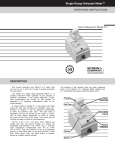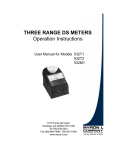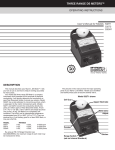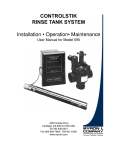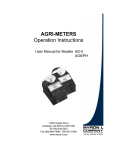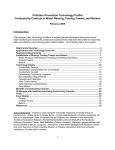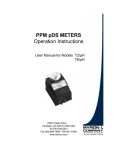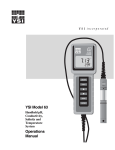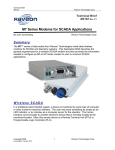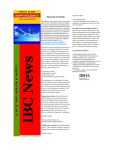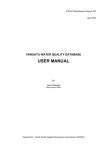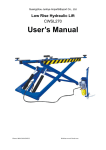Download Single Range D-1 Manual
Transcript
SINGLE RANGE DIALYSATE METERS Operation Instructions User Manual for Models D-1 2450 Impala Drive Carlsbad, CA 92010-7226 USA Tel 760-438-2021 Fax 800-869-7668 / 760-931-9189 www.myronl.com pH/Conductivity Instrumentation Accuracy • Reliability • Simplicity DESCRIPTION This manual describes your Myron L D-1 meter, tells you how to use it, and how to keep it working accurately for many years. Your Model D-1 single range Dialysate Meter is a compact instrument which operates on the principle of electrical conductivity. It wilI quickly determine if dialysate concentrations are correct. Its dial provides an expanded 11-15 millimhos (millisiemens) scale for accurate readings. A unique feature of Model D-1 is the green color band above the dial. This provides an immediate visual confirmation of whether or not the dialysate concentration is within the patient's "safe zone". The color band is adjustable and can be pre-set by the doctor or technician for each patient. Adjustment is made by turning the screw on the face of the meter. This screw may be covered with tape or a label to avoid tampering. The D-1 is 3.4" x 4.5" x 4.0" (85 x 129 x 126mm) and weighs less than one pound (0.45kg). D-1 Meters are completely selfcontained. The built-in cell is automatically temperature compensated from 60° to 105°F (16° to 40° C). They are powered by two 9 volt transistor batteries good for at least 2000 tests, or one year shelf life. A light bulb, which glows when the black button is pushed, serves as a battery reserve indicator. The pictures in this manual show the major operating parts of your Myron L D-1 Dialysate Meter. Handle your D-1 and identify these parts to become familiar with it. USING YOUR METER NOTE: Before measuring dialysate samples, check the calibration of your meter using Myron L Company 14.0 millimhos Standard Solution (see CALIBRATION). 1. Fill the cell cup to just above the top electrode with a sample of the dialysate you want to test. The dipper end of the cell plunger will deliver just the right amount. Be sure hands are clean and dry to avoid contamination of the sample. NEVER FILL THE CELL BY DIPPING THE METER INTO SOLUTIONS! 2. Drop the plunger into the cell cup. Lift it about half way out of the cell and drop it back in three or four times. Discard the sample. NOTE: This procedure must be conscientiously performed for samples at working (body) temperature to avoid artificially low readings. 3. Repeat steps 1 and 2 at least three times. 4. Take another sample, drop in the plunger, and press the black button. When the pointer stops, IMMEDIATELY read and release the button. 5. Repeat step 4 twice and record the last reading. NOTE: If using the "safe zone" color band and the reading is not within the band, immediately confirm the calibration of your D-1 with 14.0 millimhos Standard Solution (see CALIBRATION). 6. When you are finished with the meter, RINSE THE CELL CUP with clean water, preferably R.O., distilled, or deionized. CAUTION: DO NOT use with samples hotter than 105°F (40°C). The readings WILL NOT be accurate. DO NOT splash solvents such as lacquer thinner, acetone, benzene, or chlorinated solvents on the plastic case. DO NOT fix or modify the meter. That will void your warranty. See SERVICE for details or consult Myron L Company. DO NOT DIP THE INSTRUMENT INTO SOLUTIONS. If liquid does get inside the instrument, see MAINTENANCE for instructions on drying it. CALIBRATION/ACCESSORIES MAINTENANCE STANDARD SOLUTION: Myron L Company Standard Solution has a known conductivity and concentration of Sodium Chloride (NaCI). Your Dialysate meter was calibrated at the factory using our 14.0 millimhos (7.86 grams per liter NaCI) Standard Solution. You can keep your meter accurate by using the same Standard Solution. BATTERY CHECK: Model D-1 has a battery indicator glow light visible through the small hole on the lower right-hand corner of the meter face plate. If this light faiIs to glow when the black button is pressed, replace both batteries. CHECKING CALIBRATION 1. Test a sample of Myron L Company 14.0 millimhos Standard Solution. CAUTION: Throw the Standard Solution away as you use it. Don't put the used samples back in the bottle. 2. If the D-1 Meter does not indicate the 14.0 millimhos shown on the Standard Solution bottle's label, first clean the cell. For directions on how to do this, see CELL CUP opposite. Rinse the cell thoroughly and test the Standard Solution again. If the D-1 Meter still does not indicate the correct value, recalibrate it as described below. TO RECALIBRATE THE METER 1. Remove the bottom cover using fingernails or a small screwdriver to loosen the front or rear edge. Identify the Calibration Control (see photo below) so you can find it by touch while calibrating. 2. Test another sample of the Standard Solution (be careful to not splash solution inside the meter). 3. Adjust the Calibration Control until the meter pointer indicates 14.0. BATTERY REPLACEMENT: Detach the battery connectors. Pull on the plastic straps to remove the batteries. Replace with fresh zinc carbon or alkaline 9 volt batteries. Reinsert the plastic straps to secure batteries. Replace the bottom cover. CELL CUP: Self-conditioning of the built-in electrodes occurs each time the button is pressed with a sample in the cell cup. This ensures consistent results each time. With some samples a small downward swing of the pointer is a result of this conditioning action. This action is powerful and removes normal films of oil and dirt. However, if samples are allowed to dry in the cell cup, a film will build up. This film reduces accuracy. When there are visible films of oil, dirt, or scale in the cell cup or on the electrode, scrub them lightly with a small brush and household cleanser. Thoroughly rinse out the cleanser, and the meter is ready for accurate measurements. SOLUTIONS INSIDE THE METER Your Dialysate Meter is a rugged instrument and will withstand dialysate exposure around its cell, meter movement, and switches. However, care should be taken to keep solutions from leaking in around the bottom cover. It is not sealed (to prevent condensation from forming). Large amounts of calibration solution or dialysate will almost certainly damage the meter movement or electronics. Such meters should be returned to the Myron L Company for repair. If there are only a few drops inside the meter, dry it as follows: 1. Shake excess solution out of the inside of the meter. 2. Dab the exposed surfaces dry with an absorbent cloth or tissue. Avoid pushing any liquid into the Calibration Control or push button switch. 3. Air dry the meter in a warm area with the bottom cover off. Allow several hours for thorough drying. If the dialysate entered through a leak in the case or cell,or if the instrument shows erratic readings or other unusual behavior, return it to the Myron L Company for servicing. SERVICE IMPORTANT The plunger enclosed with your Dialysate Meter has been calibrated specifically for this instrument. If a different plunger is used, the Dialysate Meter MUST BE RECALIBRATED with Standard Solution. Make sure the plunger is completely seated in the cell cup. ACCESSORIES STANDARD SOLUTION Your D-1 Meter has been factory calibrated with Myron L type 14.0 millimhos Standard Solution Myron L Company Dialysis Standard Solution is made with deionized water and reagent grade Sodium Chloride, and is within 1.0% of Sodium Chloride reference solutions. Quart and gallon sizes are available. If your D-1 meter fails to operate properly: 1. Check the glow light to make sure the batteries are good. 2. Check the cell cup and electrodes to ensure they are clean. Any contamination could alter the reading. See MAINTENANCE. Any service required other than battery replacement, cleaning, or calibration must be referred to the Myron L Company. When returning an instrument, please pack it securely and enclose a note specifying the problem. The plunger should be included, but DO NOT ship with plunger in cell (damage could result). ORDERING To order accessories or instruments, contact your nearest stocking distributor, or the Myron L Company. WARRANTY/SERVICE Myron L Dialysate Meters have a limited two year warranty. If your instrument fails to operate properly, check the batteries and calibration. If it still fails to function properly, return it prepaid to the Myron L Company. Faulty instruments may be returned to us without prior permission. METERS WITHIN TWO YEAR WARRANTY PERIOD: Failures due to materials or workmanship will be repaired or replaced (our option) without charge if returned freight prepaid. If failure is deemed by the factory to have been caused by abuse or tampering, the following procedure will apply. INSTRUMENTS/CONTROLS OUT OF WARRANTY: Diagnosis will be made and repairs completed, providing the repair charges are $70.00 or less. NOTE: Actual repair charges may be less than this amount. We will diagnose (but not repair) a returned meter and mail an estimate of charges if ANY of the following apply: 1. Repair charges will be more than $70.00 2. You specifically request an estimate of required repairs and charges. 3. The cost of required repairs exceeds one-half the list price of a new instrument. 4. The instrument is over ten years old. Because of component changes and improvements, such instruments can no longer be repaired. NOTE: Unrepaired meters are discarded unless you want them returned to you. If so, there is currently a $25.00 charge per unrepaired instrument to cover diagnosis and handling. This warranty is limited to the repair or replacement of the Myron L Dialysate Meter only. The Myron L Company assumes no other responsibility or liability. pH Conductivity Instrumentation Accuracy • Reliability • Simplicity Printed in U.S.A. Specifications subject to change without notice 2450 Impala Drive Carlsbad, CA 92010-7226 USA Tel 760-438-2021 Fax 800-869-7668 / 760-931-9189 www.myronl.com © Myron L Company 2001 (W)





